| 16 February |
• yesterday • tomorrow |
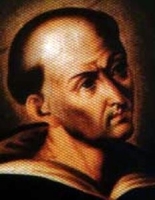
11 January (Dominicans)
Born to a wealthy and pious family, Bernard was well educated, but spent a wild and dissolute youth. During one of his revels he received a leg wound in a duel. His recovery gave him time to think, and the young man realized that he was headed in the wrong direction. As he was healed, Bernard renewed his life in the Church and then joined the Dominicans in Catania in 1452. Noted for his charitable works, his life of repentance for his earlier ways, his strict adherence to the rules of his Order, and his devotion to contemplation of Christ's Passion, which would sometimes send him into ecstacies. Founded a hospital for the poor. A gifted preacher, he preferred to spend his time in the confessional and working as a spiritual director. Had the gift of prophecy, and used it to warn people to change their lives; prophesied the date of his own death.
Legend says that when Bernard walked in the gardens of his monastery, birds would come down to sing to him, but would stop when he went into prayer. Once when a porter was sent to Bernard's room to fetch him, the man saw a bright light shining under the door, and when he peeked in he saw a beautiful child who was shining with light and holding a book from which Bernard was reading.
1430 in Catania, Sicily
• 11 January 1487 of natural causes
• fifteen years after his death he appeared in a vision to the prior in Catania and asked that his remains be moved to the house's rosary chapel
• during this movement a man was cured of paralysis by touching the relics
1825 by Pope Leo XII (cultus confirmed)
https://catholicsaints.info/blessed-bernard-scammacca/
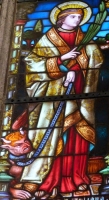
Juliana of Cumae
Daughter of a pagan named Africanus who promised the girl to a young noble named Evilase. Juliana put him off, first insisting that he become prefect of Nicomedia. When he became prefect, she insisted he become a Christian before they could marry, a condition he would never meet. Her father, who hated Christians himself, abused Juliana fearfully to get her to change her mind, but she held fast; ancients manuscripts describing these horrors put them in terms of her fighting a dragon, and she is often depicted that way in art. Evilase called her before the tribunal during the persecutions of Maximianus, denounced her as a Christian, and she was martyred. Hers was a favourite story, for telling and creation of stained glass and other art objects, during the Middle Ages.
• burned, boiled in oil, and beheaded c.305
• relics at Cumae, Naples, Italy
• against bodily ills or sickness
• sick people
• young woman battling a winged devil
• young woman being boiled
• young woman chaining up a dragon
• young woman chaining up and/or scourging the Devil
• young woman in a cauldron
• young woman leading a chained devil
• young woman standing or sitting on a dragon
• young woman wearing a crown on her head and a cross on her breast
• naked young woman hanging by her hair
https://catholicsaints.info/saint-juliana-of-nicomedia/
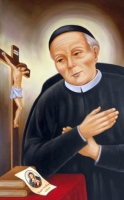
Apostle of Calabria
Mariano's family was so poor that he was placed in a home for neglected children. A priest who worked there mentored the boyand took him along to parish missions where Mariano taught catechism to children. In 1729, at age 22, Mariano moved to Naples, Italy. There he studied literature and philosophy at the Jesuit college, was tutored in theology, and ordained a priest on 22 December 1731.
Father Mariano became a model minister in Naples, working with the poor, the abandoned, the sick, the imprisoned in the streets, hospitals, and prisons. He taught, preached, and worked in the surrounding dioceses when they asked. Parish priest in Altomonte, Italy, and spiritual director of the Poor Clare house in that city.
26 February 1707 in Contursi Terme, Salerno, Italy
• 16 February 1788 in Naples, Italy of natural causes
• Saint Mary Frances of the Five Wounds saw the soul of Blessed Mariano being taken to heaven by angels
• his body remained in the church of the Assumption in Naples for three days so the locals could pay their respects; his religious habit had to be replaced several times as mourners kept tearing bits off it as relics
• buried in the church of the Assumption
• re-buried in Contursi, Salerno, Italy in 1951
• 24 June 2012 by Pope Benedict XVI
• beatification celebrated at Terme del Tufaro, Contursi Terme, Italy, presided by Cardinal Angelo Amato
Contursi Terme, Italy
https://catholicsaints.info/blessed-mariano-arciero/
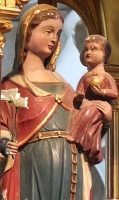
Notre Dame de l'Epine
night of 24 March 1400, the eve of the Feast of the Annunciation
On the eve of the feast of the Annunciation, some shepherds out in the fields at night saw a bright light coming from the area of the chapel of Saint John the Baptist near Chalons-sur-Marne, France. The light was coming from a bush that was engulfed in flames; the plant was unharmed as was a statue of the Blessed Virgin Mary that stood in the middle of the fire. The fire burned through the night and into the next day, the Annunciation, and crowds, including Charles of Poitiers, the Bishop of Chalons, came to see the spectacle.
When the flames finally died down, Bishop Charles carried the statue to the chapel. He then had a church built on the site of the miraculous fire; it was built so fast that the locals says angels would come at night and work on the structure. It quickly became a pilgrimage site; Saint Joan of Arc visited the site in 1429.
During the persecutions of the French Revolution, the statue was hidden, but when the persecutions ended, it was returned to the altar. Healing miracles have been reported in the church. Pope Leo XIII ordered the solemn coronation of the miraculous statue.
https://catholicsaints.info/our-lady-of-the-thorns/
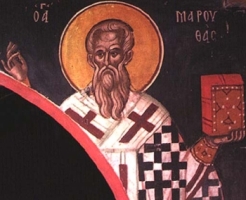
Bishop of Mayferkqat, Syria, part of the kingdom of Persia, in the late 4th and early 5th centuries. Presided over the Council of Seleucia. Worked to build and repair churches that had been lost during the persecutions of King Sapor, and collected so many of the relics that had been scattered during that time that his see city became known as Martyropolis. He composed a number of hymns in honor of the martyrs, and wrote “Acts” of as many as he could research. Because of the wealth of his theological writings, he is honored as the chief Doctor of the Syrian Church.
Maruta once went to the court of King Yezdigerd to seek an end to persecution of Christians. While there, he was able to cure the king of a series of violently painful headaches. The Zoroastrian priests, afraid that the king might convert to Christianity, rigged up a hiding place in the floor of their temple. There a priest waited, and when the king came into the temple, the priest shouted that the Christian should be sent away from such a holy place. The king was ready to obey the mystical voice until Maruta pointed out the trap door and the hidden priest was dragged out. The king did not convert, but grudgingly agreed to tolerate Christians.
c.415 of natural causes
https://catholicsaints.info/saint-maruta/
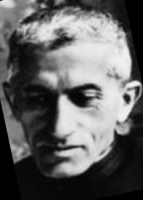
Giuseppe Allamano
Fourth of five children; nephew of Saint John Cafasso. His father died when Joseph was three years old. Studied at the Salesian Oratory in Valdocco, Italy; Saint John Bosco was one of Giuseppe's spiritual directors. He entered the diocesan seminary of Turin, Italy in November 1866. Ordained on 20 September 1873. Spiritual director of the Turin seminary. Appointed rector of the Consolata Shrine on 2 October 1880; he remodeled the shrine, and made it a source for spiritual renewal throughout the diocese. Founded the Consolata Missionary Priests and Brothers on 29 January 1901; the first missionaries reached Kenya in 1902. On 29 January 1910 he founded the Consolata Missionary Sisters for women with a missionary vocation.
21 January 1851 at Castelnuova, Asti, Italy
16 February 1926 at Turin, Italy of natural causes
7 October 1990 by Pope John Paul II
https://catholicsaints.info/blessed-joseph-allamano/
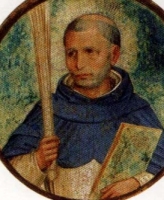
Born to the Italian nobility, in his youth Nicola received a vision of an angel who warned him not to eat meat as he would one day join a religious order that had a permanent rule of abstinence. He was a university student in Bologna, Italy when he heard the preaching of Saint Dominic de Guzman. He soon after joined the Dominicans, receiving the habit from Saint Dominic himself. Priest. Noted and successful preacher. Twice provincial of the Dominicans in the enormous province of Rome. Founded monasteries in Perugia and Trani, promoted Scripture study and the compilation of a Bible concordance. Commissioned by Pope Gregory IX to preach Crusade against the Saracens. Reported miracle worker. He spent his final years as a prayerful monk in the Dominican monastery in Perugia.
1197 in Giovinazzo, Bari, Italy
• 1256 at the Dominican monastery in Perugia, Umbia, Italy of natural causes
• buried in the church of Saint Dominic in Perugia
26 March 1828 by Pope Leo XII (cultus confirmation)
https://catholicsaints.info/blessed-nicola-paglia/
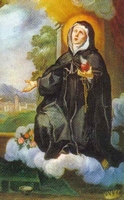
Philippa Mareria
After having met Saint Francis of Assisi in her parents' home, she became a hermit on a mountain above Mareri, Italy. Poor Clare nun. Founded a Franciscan convent in Rieti, Italy with the help of Blessed Roger of Todi. Abbess.
c.1195 at Mareri, Rieti, Italy
16 February 1236 in Borgo San Pietro, Rieti, Italy
30 April 1806 by Pope Pius VII (cultus confirmation; decree of heroic virtues)
https://catholicsaints.info/blessed-filippa-mareri/
• Pamphilus of Caesarea
• Panfilo...
Pamphilus studied in Alexandria, Egypt where he became a great defender of the works of Origen. Ordained a priest in Caesarea Maritima, Palestine (in modern Israel). Bishop. Imprisoned and sentenced to forced labour in the mines of Cilicia for two years during the persecutions of Diocletian, after which he was tortured and executed. Martyr.
16 February 309 in Cilicia, Asia Minor (in modern Turkey)
https://catholicsaints.info/saint-pamphilus-of-cilicia/
1 July (Diocese of Hiroshima, Japan)
Young layman of the diocese of Hiroshima, Japan. Martyr.
c.1600 in Yamanashi, Japan
16 February 1624 in Hiroshima, Japan
• 24 November 2008 by Pope Benedict XVI
• beatification celebrated at the Nagasaki Prefectural Baseball Park (Big N Stadium), Nagasaki, Japan, presided by Cardinal José Saraiva Martins
https://catholicsaints.info/blessed-franciscus-toyama-jintaro/
Servant of Saint Pamphilus. Protested that the bodies of the martyred Saints Elias, Jeremy, Isaias, Samuel, and Daniel should be buried. Denounced as a Christian, he was tortured to death. His martyrdom led to the death of Saint Seleucus.
torn with hooks, disemboweled, and burned to death in 309 at Caesarea
https://catholicsaints.info/saint-porphyrius-of-caesarea/
After watching the martyrdom of Saint Porphyrius, Seleucus praised the saint‘s actions. Some soldiers overheard him, dragged him in front of the tribunal, and he was martyred without further investigation.
beheaded in 309 at Caesarea
https://catholicsaints.info/saint-seleucius-of-caesarea/
Tetradio, Tétrade
Bishop of Bourges, France in the late 5th and early 6th centuries. Part of the Council of Agde in 506. Part of the Council of Orléans in 511.
mid-5th century
c.512 of natural causes
https://catholicsaints.info/saint-tetradius-of-bourges/
Man who came to the town of Cilicia on un-related business, saw the bodies of the recently martyred, kissed them and prayed for them, and was thus exposed as a Christian. Martyr.
burned in a slow fire in 309 in Cilicia, Asia Minor (in modern Turkey)
https://catholicsaints.info/saint-julian-of-cappadocia/
25 October (translation of relics)
Fourth century bishop of Metz, France.
• buried in the church San Clément aux Arènes
• relics transferred to the Benedictine of Saint Peter in Senones c.770
https://catholicsaints.info/saint-simeon-of-metz/
Leader of a group of martyrs, some or all of whom may have been imperial soldiers. The dates are unknown, and none of the names of his companions have come down to us, and we have no other details of their demise.
martyred in Egypt, date unknown
https://catholicsaints.info/saint-julian-of-egypt/
Bishop of Brescia, Italy c.360. Legend says that he was a relative of Saint Faustinus and Saint Jovita, and we know that he researched and wrote their Acts.
381
https://catholicsaints.info/saint-faustinus-of-brescia/
Patriarch of Constantinople in 565. Established regulations that became the code of laws known as the "Nomocanon".
577
https://catholicsaints.info/saint-john-iii-of-constantinople/
Monk and abbot in the late 10th and early 11th centuries. He is mentioned in some documents, but little about the man has survived.
https://catholicsaints.info/blessed-archinrico-of-montmajour/
Benedictine monk. Abbot of Saint Gabriel's monastery at Airola, Campania, Italy.
1050
1100 of natural causes
https://catholicsaints.info/saint-aganus-of-airola/
Priest. Bishop of Ephesus. Supported Saint Ignatius of Antioch.
https://catholicsaints.info/saint-onesimus-of-ephesus/
Martyr.
https://catholicsaints.info/saint-juliana-of-campania/
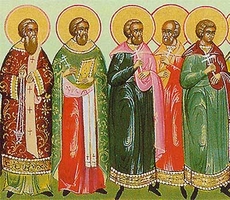
A group of Christians who ministered to other Christians who were condemned to work the mines of Cilicia in the persecutions of Maximus. They were arrested, tortured and martryed by order of the governor Firmilian.
• Daniel
• Elias
• Isaias
• Jeremy
• Samuel
The group also includes the three known have been sentenced to the mines -
• Pamphilus
• Paul of Jamnia
• Valens of Jerusalem
and those who were exposed as Christians as a result of these murders -
• Julian of Cappadocia
• Porphyrius of Caesarea
• Seleucius of Caesarea
• Theodule the Servant
309 in Cilicia, Asia Minor (in modern Turkey)
https://catholicsaints.info/martyrs-of-cilicia/
CatholicSaints.Info Portable Edition